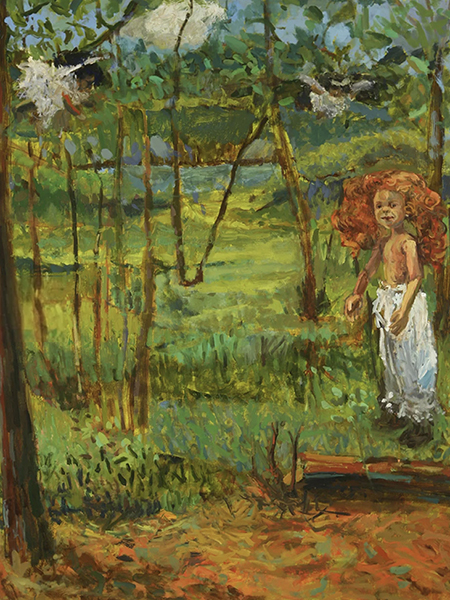
Continuing through October 29, 2023
Northwest poet Elizabeth Donnally wrote in 1971: “Pine trees/Pine trees/Pine trees/Pine trees/Pine trees/Thank you very much,” thereby anticipating the centrality of trees in our time of severe climate change and expressing gratitude for their presence. They cleanse the air; they provide shelter and shade; they inspire art as well as poetry in the manner of Gertrude Stein, Robert Frost, Henry Wadsworth Longfellow and others. ”Trees, Fox & Friends” assembles an impressive survey featuring the tree as subject: figurative, abstract, realistic, photographic and so forth. The nine artists here take as their premise the significance of the tree in our environment as breathing lungs, wildlife habitat and landscape anchor, securing the earth against erosion, and providing nourishment for ancillary organisms. Taken together, the paintings, collages, prints, and watercolors demonstrate how wide-ranging a departure point for personal expression the tree can be.
Lisa Sheets’ “Forest” is like a replay of the climactic final scene of Alfred Hitchcock’s “Strangers on a Train,” with its runaway merry-go-round (or rollercoaster as seen here), embracing couple, and overarching tree branches. Sheets blends photographic sources with dreamy screens. It is the most explicitly urban work on view. Amy Scherer describes city backyards in her small, 12-by-12-inch, acrylic-on-paper scenes, like “Environmental Field Study” (2016), “Field Near House” (2019-22), and the minuscule “Juanita Beach” (2016), at five-by-five inches. Scherer’s miniaturizations force our focus onto her tight compositions, reinforcing the mock-scientific character in each work.
More romantic, Rob Vetter’s extrapolations on trees in the San Juan Islands — such as “Squalicum Tree” and “Guemes” (both 2022) join the imaginary “Wide Sargasso Sea” (2021), borrowing its title from a 1966 novel by Jean Rhys. At four-by-two feet, it is the largest among Vetter’s smaller oils on panel, but stretches our notion of how far trees can extend. Cropped and clipped at the top, the other trees are foregrounded but shoehorned into tight compositions that open onto other bodies of water such as the Salish Sea (formerly known as Puget Sound).
Laura Hamje is best known for her exploration of the demise of the Alaskan Way Viaduct in Seattle, a 1950s waterfront traffic eyesore that cut off the downtown area from Elliott Bay. With “Slow Seep” (2022), Hamje further diminishes the presence of trees, setting them at the picture’s upper edge behind a glistening morass of ferns, leaves, and branches. The work approaches the mystical luminism of New York Regionalist Charles E. Burchfield, with a comparable central glow and hovering haloes around much of the leafage. The forest floor has never looked so alive, conveying how fertile the tree’s root lines underground can be. Similarly, Christie Houston’s “The Hopefuls” (2022-23) isolates maple leaves in various stages of seasonal decay, floating on a ground of white with unnecessary scrawls of words like “Hope,” “Love,” and “You.” Yes, the subjective is introduced through language, but to little meaningful end.
The earliest works on view (1992) are “Purple Flowers” and “Red Flowers” from Dan Brooks’ “Infinity Garden” series. They demonstrate the abstract potential of the trees’ flowers. While trees are boldly present in their verticality on both three-by-two-foot canvases, blurry colored circles dominate each composition, pushing outward toward the viewer, leaving the tree as a looming backdrop. These are among the most accomplished works on view. They contrast sharply with Aurora Fox’s strictly illustrational selection of eight gouaches and watercolors on paper, each graphically depicting logs and tree trunks. “Ode to the Woodpile” (2022-23), the more saccharine “Wheel of Sacred Animals” (2016), and “Here Comes the Sun” (2022-23) are worthy of note cards, skillfully executed but not full-fledged works of art. Heavy with graphic outlines and sharply demarcated colors, they literalize the theme of trees where the other artists personalize or poeticize it.
The largest painting on view, “Promised Land” (2022) by Carol Adelman, is inspired by a forest in Pennsylvania. She adds a small child or doll at its edge, as if to invite us in. This, too, could be the cover of a children’s book, but its mastery of oil and dazzling brushwork lift it onto the plane of fine art. The size and height of the trees diminish in the distance, taunted or teased as if in an unnamed folk or fairy tale. Its mystery and beguiling ambiguity are retained by an active painterly attack, with the trees deeply shadowed and ominous. Joined by three other smaller studies of “Trees: Bellaire” from 2004, Adelman completes the journey among tree trunks, branches, and limbs. In this survey, the artworks bear intimate discussion, both with us and with each other.
